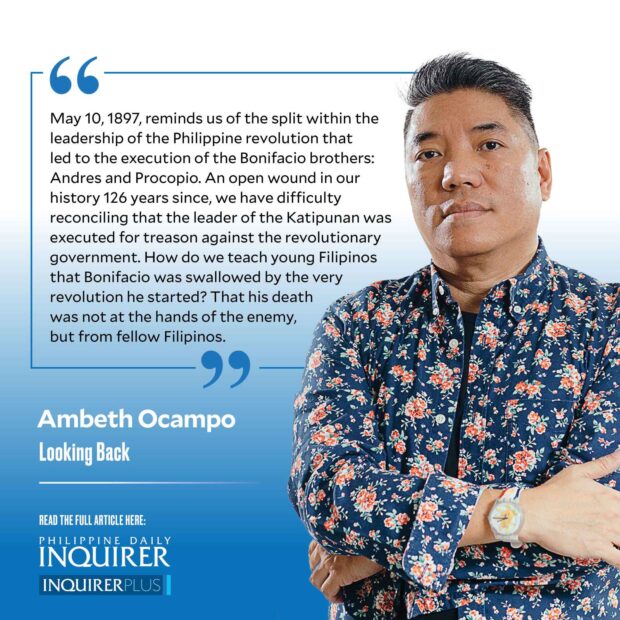A Bonifacio pilgrimage
Had Andres Bonifacio died of old age or natural causes on May 10, 1897, the date would not be controversial. However, May 10, 1897, reminds us of the split within the leadership of the Philippine revolution that led to the execution of the Bonifacio brothers: Andres and Procopio.
An open wound in our history 126 years since, we have difficulty reconciling that the leader of the Katipunan was executed for treason against the revolutionary government. How do we teach young Filipinos that Bonifacio was swallowed by the very revolution he started? That his death was not at the hands of the enemy, but from fellow Filipinos.
In April 1997, I traced the last steps of Bonifacio from the Maragondon house where he was tried (now a National Historical Landmark) to the contested site of his execution on Mount Nagpatong (now an ecotourism park). Following the advice of Teodoro Agoncillo, I drove to Maragondon, Cavite, and continued my pilgrimage on foot. I entered Maragondon from the street leading to the Puerto Azul Beach Resort on Caylabne Bay.
From the municipio, I walked down to the town plaza toward the church, turned left then took a sharp right turn on a narrow street toward Barrio San Nicolas. There I found a river at the end of the road, and saw a bridge farther upstream.
To cross the river, I was directed to backtrack and look for an alley without a name, marked by a road side halo-halo stand under the shade of a suha or pomelo tree. It didn’t help that the tree had no fruit that day, and that I could not tell a suha from a mango tree even if my life depended on it.
Fortunately, curious children surrounded me and were bribed with a fistful of hard candy to escort me to the alley, driving away stray dogs along the path. I crossed a rickety hanging bridge that connected Maragondon with Pinagsangahan (also called Ibayo) and met an old lady who volunteered to show me the spot where the Bonifacio brothers were executed.
I followed her to a clearing in the direction of the execution site where she endorsed me to a group of shirtless men lounging on a papag across her home. Peter Madelar, a former cook at Puerto Azul, left the group and guided me to the Bonifacio monument, a three-kilometer, 45-minute walk through parched, formerly cultivated ground, passing through uninhabited lots to the site on Mount Nagpatong marked by a lonely, neglected, squat monument, not quite an obelisk.
Around it were alibangbang trees, whose tart fruit is sometimes used as a sinigang souring agent.
Erected by the Legionarios del Trabajo in November 1925, the historical marker stated that it was meant, “to perpetuate to future generations that on April 26, 1897, the cadaver of Andres Bonifacio was interred in this spot.” Textbook history, and known primary sources, place the date of execution as May 10, 1897.
This was not the only question that bothered me on that visit. I had learned from school that Bonifacio was executed either on Mount Buntis or Mount Tala, not Nagpatong. Asking locals about the names of the hills in the area, I was told these were: Nagpatong, Pumutok, Buntis, and Hulog. Were these names related to the sexual act? When I asked about Mount Tala and how to get there, everyone broke out laughing and exclaimed, “Bago ka umabot sa Tala lawit na ang dila mo sa Tarik!”
The locations did not make sense. Lazaro Makapagal, head of the execution party, said he read the order of execution to the two brothers on Mount Tala. We presume they were executed nearby, not on Nagpatong, Buntis, or Hulog. Teodoro Agoncillo had made the same trek half a century before mine and, in 1984, he told me: “In the time of writing you have to forget the present—if you can do that. Try to live in the period you are writing … it is a myth in Cavite na kapag ang Buntis ay nagtapis ng ulap may mangyayaring madugo. Sinulat ko iyan [in his 1956 book “The Revolt of the Masses: The Story of Bonifacio and the Katipunan”] … but people who have no appreciation for literature would never see that. Puro factual.”
I don’t know what new things I will learn by revisiting the Bonifacio execution site with what I know today in 2023. What I do know is that every generation writes its own history, from its viewpoint.
Comments are welcome at aocampo@ateneo.edu





















